Psoriasis, whose initial stages can occur through a set of factors, manifested in the form of red patches with clear boundaries.They are then covered with silver-white scales and merge with each other.Often, patches are found in the head, knees, and elbow areas.Psoriasis can affect patients of any age and gender.Psoriasis cannot be cured until the unexplored cause of the disease is over, but if you start treatment in the initial stages of psoriasis development, the symptoms of the disease can be significantly alleviated and relieved for a long time, thus fully assessing the initial signs of psoriasis.
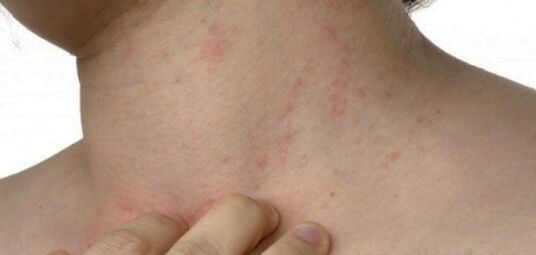
Symptoms of the initial stage of the disease
To identify the initial stages of the disease, it is important to know what the main symptoms are.Initially, a single papule appears, which can range from a few millimeters to 2-5 cm and has the shape of a patch, covered with white scales.When they are scratched, the characteristics of the psoriasis triad are manifested:
- "Starlight Spots" (light compartment of scales during scratching);
- "Terminal membrane" (exposed by shiny, thin and wet skin after removing scales);
- Symptoms of "blood dew" (small droplets of blood similar to dew appear on the skin surface as the end membrane is further removed).
The initial stage of the disease is characterized by the occurrence of psoriasis in certain places, most commonly any form of trauma.Usually, these are the elbows, the area of the knee that is a comb or scratched.These manifestations are called "Kebner's symptoms."Initially, the papule rash spreads directly at the irritating location and can last for a long time without dynamics.These rashes are called "guards."The rash is itchy and itchy.The initial phase lasted for several weeks.Subsequently, papules increase and merge into psoriatic plaques, which can cover important areas of the human body.Psoriasis can appear anywhere.The most dangerous rash on the face is the initial stage of this form is very rare.
Characteristic location of disease localization
The most common rashes observed:
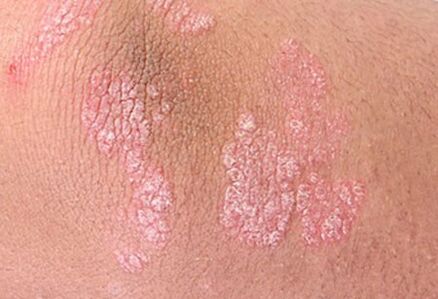
leg.The initial stage of psoriasis on the legs develops from a single small rash that is mainly located on the feet and knees but can appear on any surface of the legs.
Elbow.On the elbow, the most common plane occurs, and its symptoms are characterized by small red rashes and severe peeling.At the same time, hardening of the skin was observed on the elbow.Additionally, the rash on the elbow may be symmetrical.
nail.On nails, psoriasis manifests similar to a fungal infection.First, longitudinal bars (dots) appear on the edge of the nail (in the photo), and then they spread towards the root of the nail.Meanwhile, the nail plates began to thicken.As the symptoms of the disease develop, the area of the nail can be completely exfoliated.
Face.Psoriasis is very rare on the face because this form of psoriasis is considered atypical.High papules appear in the areas of the eyelids, nasolabial folds, eyes and eyebrows (in the photo).On rare occasions, the rash on the face appears in the red bachelox on the lips and mucous membranes (cheeks and tongue).
The specificity of the rash on the face is associated with delicate, sensitive skin and rich nerve endings.First, papules appear (small, slightly lifting the skin, nodules) and are accompanied by severe itching.Subsequently, epithelium and plaques appear on the top of the knot.
hand.Symptoms of psoriasis occur suddenly, appearing in the form of a small rash (in the photo), which many patients regard as allergic.And only when gray scales appear on the hands, palms and elbows can the patients seek help from the dermatologist.Characteristically, a similar manifestation is observed on the legs if there is a psoriatic rash on the palm.Psoriasis manifestations on palm trees are most often located between fingers, explained by the most favorable environment in this place.The back frequency of the brush is much less.When psoriasis spots appear at fingertips, their sensitivity may be lost.
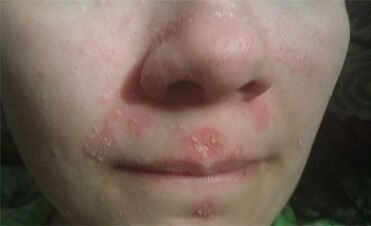
Photos of psoriasis in the initial stage
- Online decryption tests - urine, blood, general and biochemical.
- What do bacteria and inclusions mean in urine analysis?
- How to understand children's analysis?
- Functions of MRI analysis
- Special tests, electrocardiograms and ultrasounds
- Values of norms and deviations during pregnancy.
What's this?Psoriasis is a non-communicable skin disease and therefore cannot be infected.It not only affects the skin, but also negatively affects the entire organism.It is characterized by chronic curriculum with periods of deterioration and recovery.This disease is caused by the immune cells of one's own body, which is an autoimmune disease.These cells rise from deep into the upper layer, causing inflammation, excessive division of epidermal cells, leading to overgrowth, and new small capillaries appear.Externally, it looks like a formation of red or crimson spots - psoriatic plaques.
The first signs and symptoms of psoriasis
Because of psoriasis - a systemic disease that affects all systems of the body, patients suffer from general weaknesses and rapid fatigue.The main symptoms of the initial stage of psoriasis are psoriatic rashes and plaques, however, it is accompanied by a person with a disease further development.They are produced by the acceleration of uncontrolled cellular cells located on the upper layer of the skin-thyroid-forming cells.As new capillaries are enhanced, related cells are formed, and the skin in these areas thickens, obtaining red.This can cause any (even light, yet gentle) drip bleeding to the plaque.The surface of the plaque is usually covered with grey raids, similar to paraffin.The term "paraffin lake" has even been formed.The plaque consists of dead epithelial cells that accumulate on the surface of the plaque due to impaired rejection processes.Spots can reach large sizes and merge with each other.Their touch is hot, usually accompanied by severe itching.A comb can cause infection.

As time goes by, nails begin to change.Their surface becomes exhausted, stress occurs, and pink spots are noticeable under the nail plate - the accumulation of liquid, the nails turn yellow and thicken, taking the form of poultry claws.All of this happens due to violating the nutrition of nails and blood circulation.The nail bed is subjected to excessive keratosis, which leads to the rejection of nails and losses.There is usually a red inflammation border around the nails.The facet joints are affected by disease and facet joints - accompanied by pain and inflammation.In addition to plaques, there is psoriasis, which forms papules on the skin - small (about 1 mm) protruding formation similar to a rash.It is usually positioned on the elbows and knees, retained even during remission.During the improvement process, the patches begin to glow from the middle, taking the shape of the ring and can disappear completely.The pigment area remains in its place.Psoriasis on the scalp has the same symptoms as in the body.In this case, the hair structure will not change.The rash also covers adjacent areas of the skin - behind the ears, around the neck.
Types of psoriasis
According to the symptoms, the disease is divided into two types: pustules and unlabeled.There are several diseases within these groups.
The form of pustule psoriasis:
- broad sense;
- Circular
- Palmoplantar (mainly affects limbs);
- ladomary;
- Theft of psoriasis.
- Common (chronic plaque psoriasis);
- Erythropathy.
In addition, the following types of diseases are distinguished:
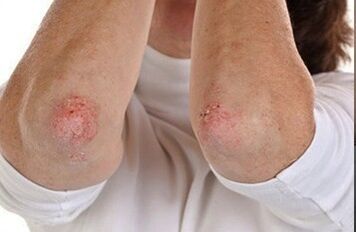
- psoriasis from napkins;
- psoriasis on skin folds and flexion surfaces;
- Seborrheic
- drug.
- Light (affected by less than 3% of the body surface);
- Average (affecting up to 10% of the body surface);
- Weight (more than 10% of the surface is affected).
Depending on the form of the rash, this type of psoriasis is distinguished:
The development stage of psoriasis, symptoms
The first batch of plaques appear in areas with dry skin and will never happen where the skin is too wet.First, the appearance of the spots can be seen inside the elbows, under the knees, the boundaries of the hair, and where there are any injuries or frictions.This position is usually symmetrical.Perform such phases during the disease:
- Progressive (formation of new sites, existing growth, itching, obvious peeling);
- Fixation (slowing or suspending plaque growth, no newly formed spots);
- Regressive (reduce or lack of peeling, stain disappearance and plaque disappearance, and pigmented skin areas appear in their location, with little signs of psoriasis).
There are no special tests to establish the diagnosis.Diagnosis is based on external features.One of these signs is bleeding when scratching the plaque, being covered with bloody dew of the spotted w.Another specific sign of psoriasis will be the presence of a pale border around the young papules, not yet covered with scales.This is the vascular reaction of the skin's appearance, which means the progress of the disease.In severe forms of disease, blood conditions may change.Signs of flow inflammatory processes occur.In some cases, you must perform a biopsy to rule out other skin diseases and confirm the presence of psoriasis.

Effective treatment of psoriasis
In the treatment of psoriasis, topical and internal therapy, physical therapy and hydrotherapy are used.During the initial mild course of the disease, use medication in the form of ointments.First, use a simple ingredient ointment and face cream, then go to a ointment containing hormones.Creams for psoriasis should be applied only to plaques and spots.With the average and severe course of the disease, use internal products that affect the entire body but give the best results.This group includes vitamin A, immunosuppressants, and cell inhibitors.Physiotherapists bring tangible relief to patients with psoriasis, which can inhibit the development of the disease and sometimes replace the use of certain drugs.UV irradiation (phototherapy), laser, ultrasound and magnetic therapy, high temperature, electronics, electrophoresis, electrophoresis.Psoriasis can gain resistance to treatment over time, so it is recommended to change the method (treatment rotation) from time to time.The head manifestation of this disease is the same as that treated with ointments and physical therapy as in other parts of the body.
Psoriasis diet
Nutrition should help adjust metabolism and prevent the appearance or exacerbation of skin symptoms.Since almost all patients violate lipid metabolism, low-fat products should be preferred.The special fire diet, Pegano has earned a wide reputation.When compiling diets, you need to try to follow some simple rules:
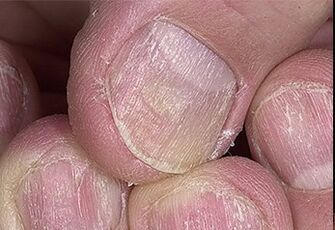
- Reject alcoholic beverages;
- Food is up to 6 times a day, little by little;
- Exclude fried foods from your diet;
- Reduce the salt content in foods;
- Do not consume foods with dyes, stabilizers and other nutritional supplements if possible;
- Exclude citrus fruits;
- Increase the share of vegetables and cereals in the diet;
- Mandatory use of vegetable oil.
Following these simple rules will help avoid exacerbation of psoriasis and independently form a therapeutic diet.
Photos of the initial stage of psoriasis symptoms
In one of the main symptoms of psoriasis in the initial stage, the appearance of epidermal-acauliform elements is distinguished.In the early stages of psoriasis, in the photo, the papules appear small, with a pink head overhead, a hemispherical pink forming with a smooth, smooth surface.A few days later, they were covered with silvery white, slight scales.This manifestation is called "point" psoriasis.Psoriasis is characterized in early stages by the growth of new small elements of psoriasis or the first sign of existing psoriasis.

The existence of Kebner phenomenon is almost installed based on linear psoriatic elements, for example, after any injury, after combing out severe itching, etc.Finally, with the progressive stage, the patient feels itching of various intensities, which is usually not a characteristic of other stages of the process.The duration of the gradual phase is the individual.Typically, the gradual phase lasts from 2 weeks to several months.It is during this time that non-hormonal ointment for psoriasis is best used as a prevention and further treatment.
The regression phase of psoriasis is the final phase of the psoriasis cycle.It is accompanied by a decrease in peeling, a gradual flattening of the central element and its subsequent full resolution.In this case, pictures of various numbers (arcs, trapezoids, rings) can be obtained.In this case, psoriasis is called "geography."There may be another way to solve the element at the beginning of the element.No scarring or atrophy was formed.The allowable element location may have pigmented tones or areas without pigment (cowhide desserts).These changes are temporary.It should be noted that this split is largely conditional.In some cases, it is difficult to establish the stage of the process immediately.In this case, the diagnosis of psoriasis is established after the patient is observed.























